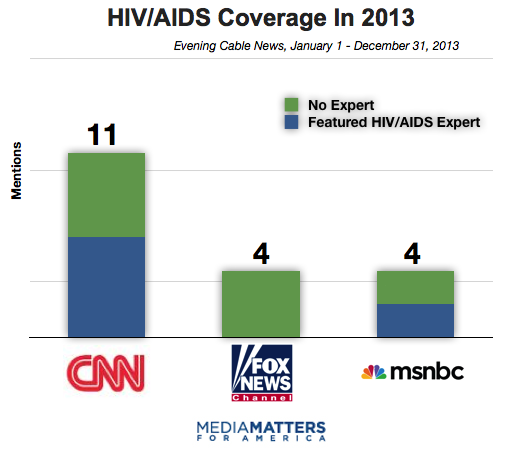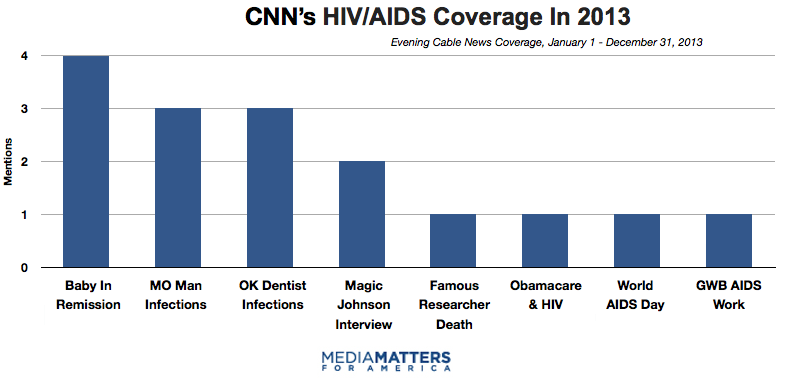Significant steps have been taken in the fight against HIV/AIDS over the past several years, but media coverage of the issue all too often fixates on stories that sensationalize the spread of the disease and even encourage the criminalization of people with HIV.
A new Equality Matters report examining evening cable news coverage of HIV/AIDS stories found that cable news networks largely ignored some of the most significant developments in the fight against HIV/AIDS in 2013:

But even while news outlets have ignored major progress in the fight against HIV/AIDS, many continue to highlight crime stories that sensationalize the spread of HIV. A look at CNN's evening coverage of HIV/AIDS stories in 2013, for example, reveals that, after the story of a baby who's HIV was in remission after early antiretroviral drug treatment, the network's top two HIV/AIDS topics were about a Missouri man who knowingly infected sex partners with the virus and an Oklahoma dentist whose unsanitary equipment may have infected patients:

Sensationalist news coverage, especially when it comes at the expense of serious reporting on the fight against HIV/AIDS, has real and damaging consequences for people living with the disease. As the LGBT advocacy group GLAAD notes, stories like the case of the Missouri man are used “to justify salacious and vilifying coverage that perpetuate stereotypes against HIV+ and LGBT communities”:
This story directly relates to the matter of treating people who have HIV as criminals, while overlooking many of the realities with which such people struggle, like stigma and fear. Many media outlets have effectively reinforced the very issues they fail to acknowledge.
Rather than inform the public of the realities of living with HIV/AIDS, these kinds of stories encourage panic and further stigmatize an already marginalized community, which in turn worsens the problem of attempting to combat the spread of HIV.
While the political landscape around LGBT rights has shifted significantly, the stigmatization of HIV/AIDS patients hasn't disappeared, resulting in a number of states adopting draconian and wildly counterproductive criminalization statutes. GLAAD points to the state of Iowa, where a law on the books until earlier this year led to extraordinarily harsh punishments:
In Iowa, for instance, exposing a person to HIV was punishable as a Class B felony as recently as a few weeks ago. The term “expose” was perhaps generously applied, though; in one case, a man was sentenced to 25 years in prison because--despite using condoms, being on medication with an undetectable load, and not infecting his partner at the time--he did not disclose his status. In late February, the Iowa Senate voted unanimously to update the law such that it criminalizes intentional transmission without consent. Senator Matt McCoy said that, while the bill isn't perfect, it is an important step. “We are sending a message that we will no longer stigmatize one particular group in our state,” he told the Des Moines Register.
What's more, Ace Robinson of the Lifelong AIDS Alliance notes that many HIV criminalization laws punish people for exposing someone else to any of their bodily fluids, including saliva, urine, and feces. HIV can't be transmitted through such fluids.
Laws criminalizing people with HIV/AIDS don't occur in a vacuum. They aren't possible unless patients living with HIV/AIDS are seen as unique threats. Hyping stories like that of the man in Missouri helps generate public panic, which in turn can lead to irrational and unduly harsh policies. Given that a majority of Americans rely on the media for information about HIV/AIDS, emphasizing sensationalist stories while ignoring major progress in the fight against HIV isn't just counterproductive - it's dangerous.
METHODOLOGY
Media Matters searched news transcripts on Nexis between January 1, 2013 and March 31, 2014, using the search term “allcaps(HIV) or allcaps (AIDS)” during CNN's weekday evening news broadcasts. All segments that focused on stories involving HIV/were included. Passing mentions, teases for upcoming segments, and reruns were excluded.
Evening cable news shows included in the study: The Situation Room, Erin Burnett OutFront, Anderson Cooper 360, Piers Morgan Tonight, and CNN Tonight.